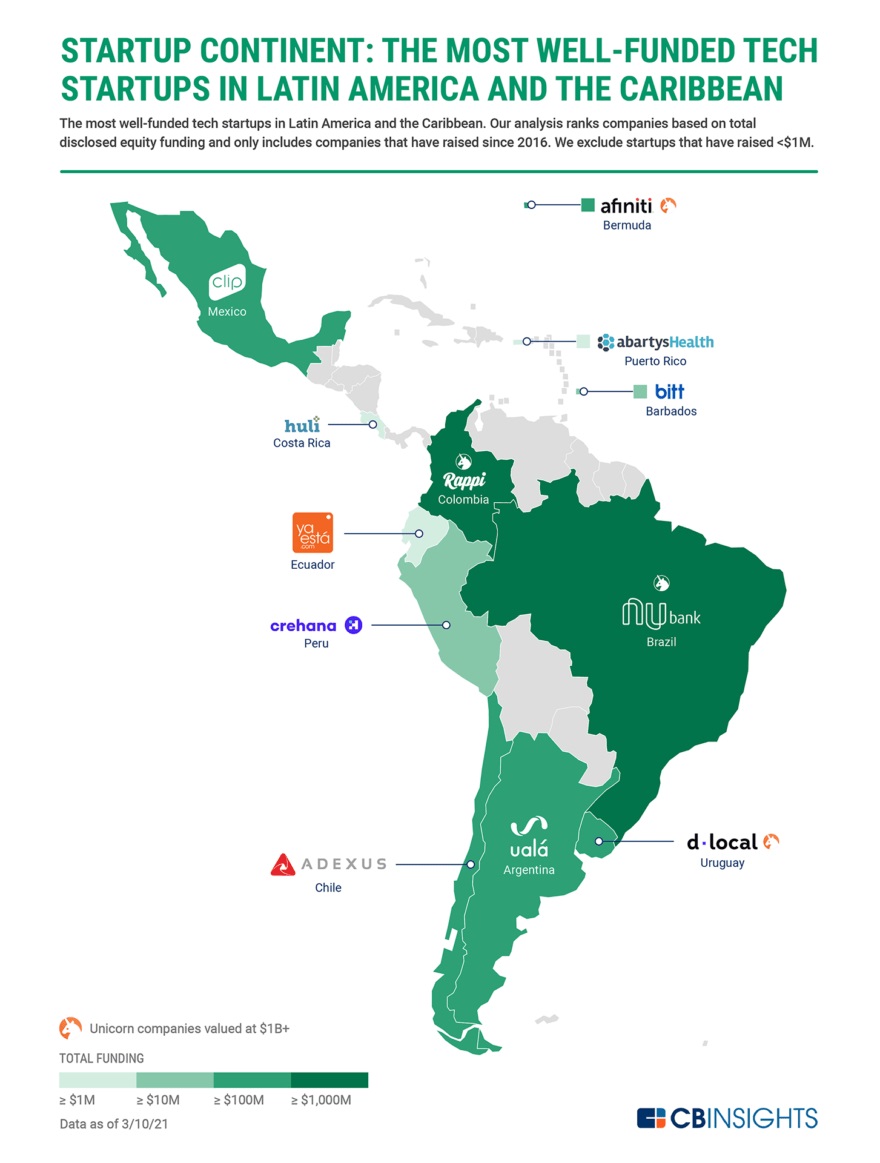LATAM's Tech Boom
January 30, 2022 | Expert Insights

Since the 1980s, the Latin American economy has struggled with several structural issues, but now finally, there is an opportunity for revival. Increasing digital penetration promises to usher in greater and more sustainable development, despite the never-ending struggle to end military dictatorships and authoritarianism in the region.
Background
From the 1950s to the 1980s, Mexico and Brazil were among the most thriving economies, and their growth had rivalled post-war Korea and Japan. However, since the debt crisis of the 1980s, Latin America fell significantly behind. Over the past four decades, countries in the region struggled to pull themselves out of this situation. Irrespective of whether a right-wing or left-wing government was in power, the pervasive inequality persisting in LATAM seemed permanently embedded.
Many nations were also overwhelmed by high crime rates and violent insurgencies by indigenous and dispossessed populations. According to the World Population Review, four out of the top ten crime-ridden countries in the world today are in LATAM.

Analysis
During the COVID-19 pandemic, LATAM was one of the worst-hit regions in the world, a testimony to its poor infrastructure, political instability and corruption. Fortunately, some form of revival is now a very real possibility.
In 2021, over 20 billion dollars of venture capital had gone into the region. This was a quadruple jump from 2019. Since 2015, investment has also gone up over 10 times, which is an even faster growth rate than that of Asia. This post-pandemic surge in investment is a part of a broader global trend. It is clear that investors feel confident about Latin America's future. They believe that there is a high potential for growth. From 2010 to 2020, the value of the tech sector in the region went from 7 billion to 221 billion, and this sector only represents 4 per cent of the region's GDP.
Most of the innovation in the region has been witnessed in fintech. Latin America has the most profitable banking sector in the world. Many argue that this is due to a lack of competition and insufficient regulation, which allows banks to hold fewer assets and charge higher interest. In Brazil, for example, five banks had essentially controlled the entire market for a long time. The fintech revolution acted as a disruption in this space, and the pandemic only accelerated the same. Around tens of millions of unbanked people have now come within the ambit of the financial sector. Other industries such as health care, education and infrastructure are also ripe for reform, according to Cristóbal Undurraga, who used to direct InnovaChile.
Moreover, the larger population has undergone a shift in their mentality. Digital penetration is increasing, and the middle class especially is becoming more tech-savvy. It is also important to note that growth is not only occurring in large countries like Brazil and South America; opportunities are presenting themselves all across the region, even in countries like Colombia and Chile. The potential for growth in the future is vast as the region's middle class continues to expand.
Although the pandemic has devastated the region, it has also ignited a start-up boom. In fact, Marcolibre has become the highest valued company in Latin America. It was even able to surpass Brazil's state oil firm. As purchasing power increases and the use of the internet also grows, start-up opportunities will only scale up further. According to the IDB Lab, Latin America invests 7$ per capita on start-ups, which is 7x less than China and 117x less than Israel. With time, investments will keep increasing in Latin America, thereby boosting its chances for success.
The success of the tech space in the region is primarily due to how they can solve problems created by structural flaws (which are region-specific). Buying used cars, renting apartments, opening bank accounts were all challenging tasks that have been made easier due to entrepreneurship. In other words, new players are now disrupting spaces that legacy actors have traditionally controlled.
Latin America is also a region that has abundant natural resources, and the U.S. has been signalling its intent to bring these supply chains closer home. This is an opportunity that the region can veritably capitalize upon.
Counterpoint
Although technology promises a better future for the region, it is not enough. To ensure continued growth and investment, a functioning government is also required. A robust legal system is needed to ensure that investors are confident in investing their money. Strong public services and government policies are necessary to help fix structural issues, uplift more people out of poverty and address inequality in the region.
There are also other issues such as the lack of sufficient skills; only 40,000 software engineers are trained out of the region, which will need to significantly increase if Latin American countries are to witness significant development.
Finally, there is a lot of uncertainty about the governments in the region. Countries like Chile have voted hard left, while others like Argentina have moved slightly to the right. Experts are concerned about the impact that these governments may have on regional development.
Assessment
- The Latin American region has struggled for the past four decades; however, the tech boom is looking to turn things around. Although the pandemic was devastating, it has helped to fuel the growth of this sector. Investment in the region is reaching all-time highs, and new and innovative companies are emerging to solve native issues.
- While some experts are worried about the impact that left-wing governments may have on the sector's growth, others argue that such governments (like the new one in Chile) can help solve many structural issues pervading the region. This, in turn, may prove to be beneficial for overall growth and development. Either way, Latin Americans will have to prioritize solutions over ideology.








Comments